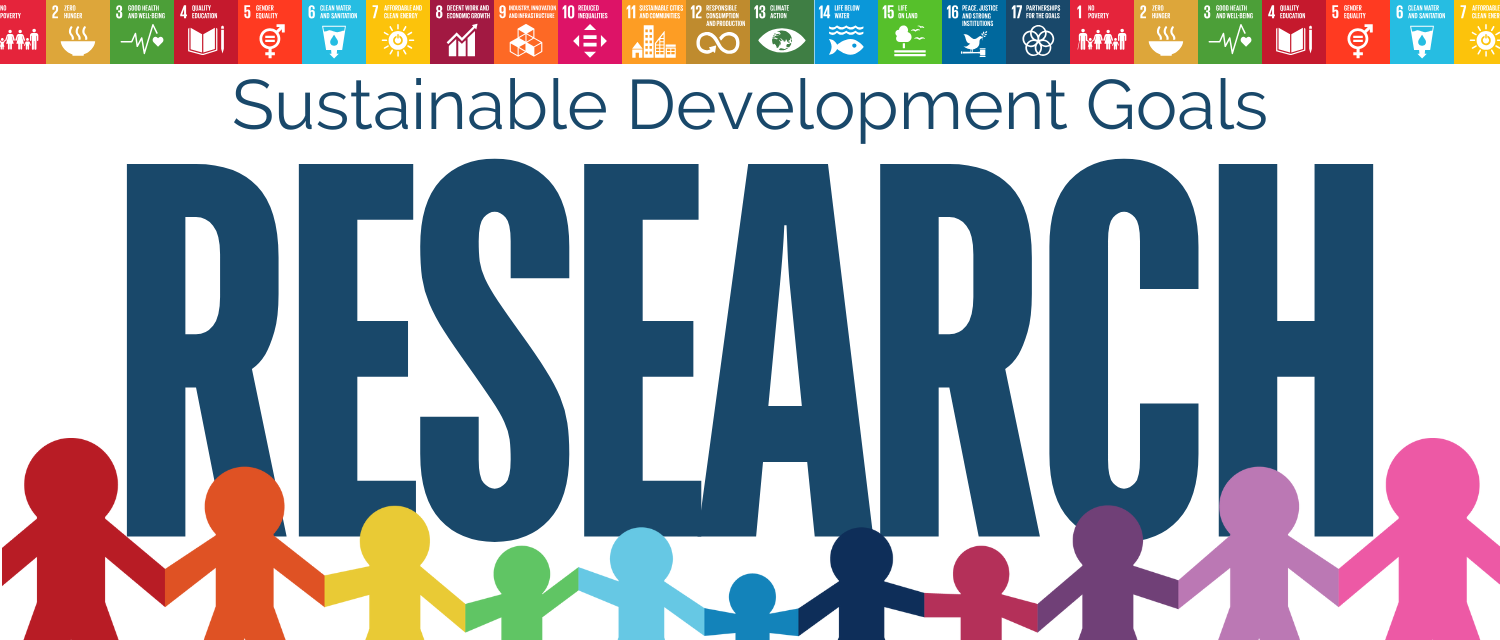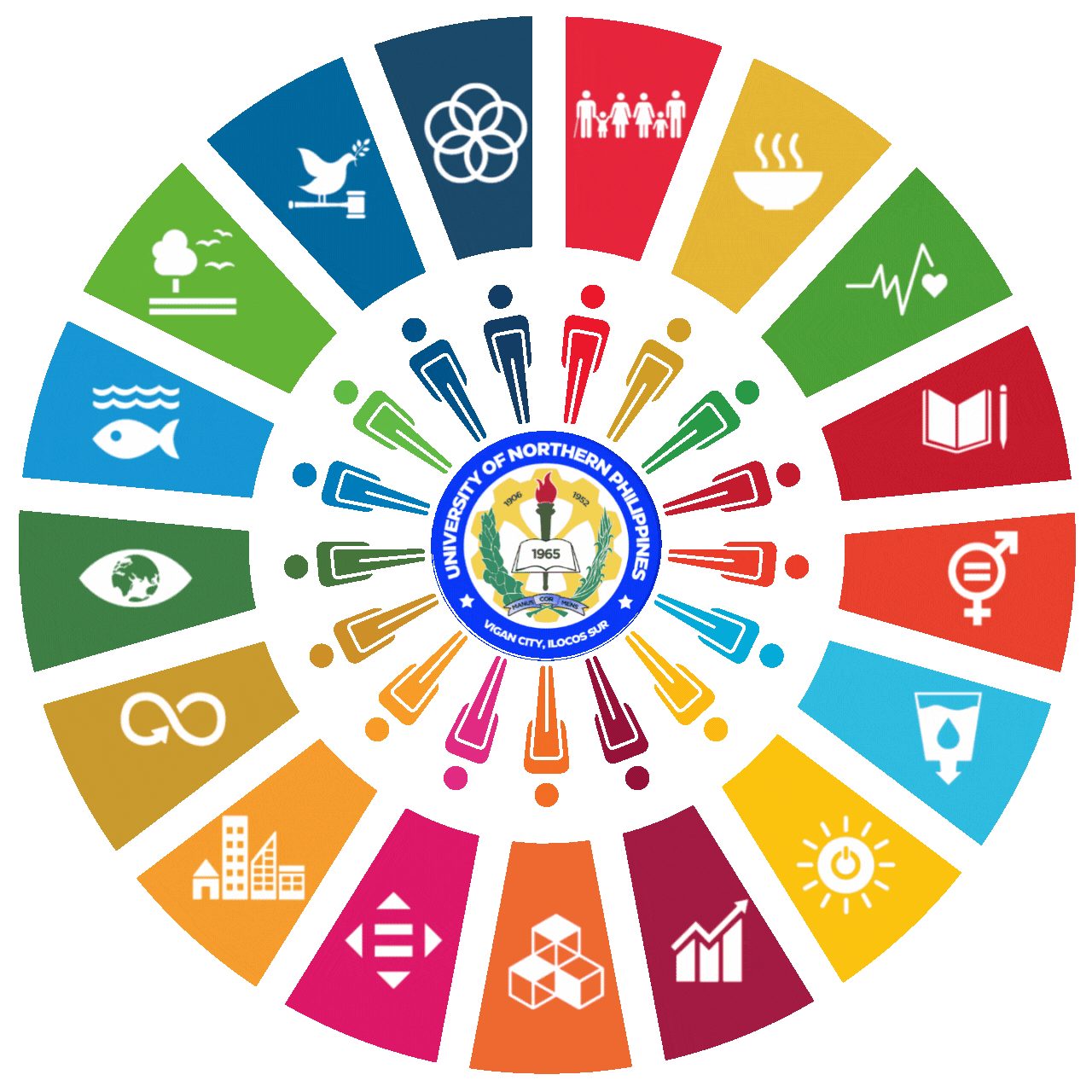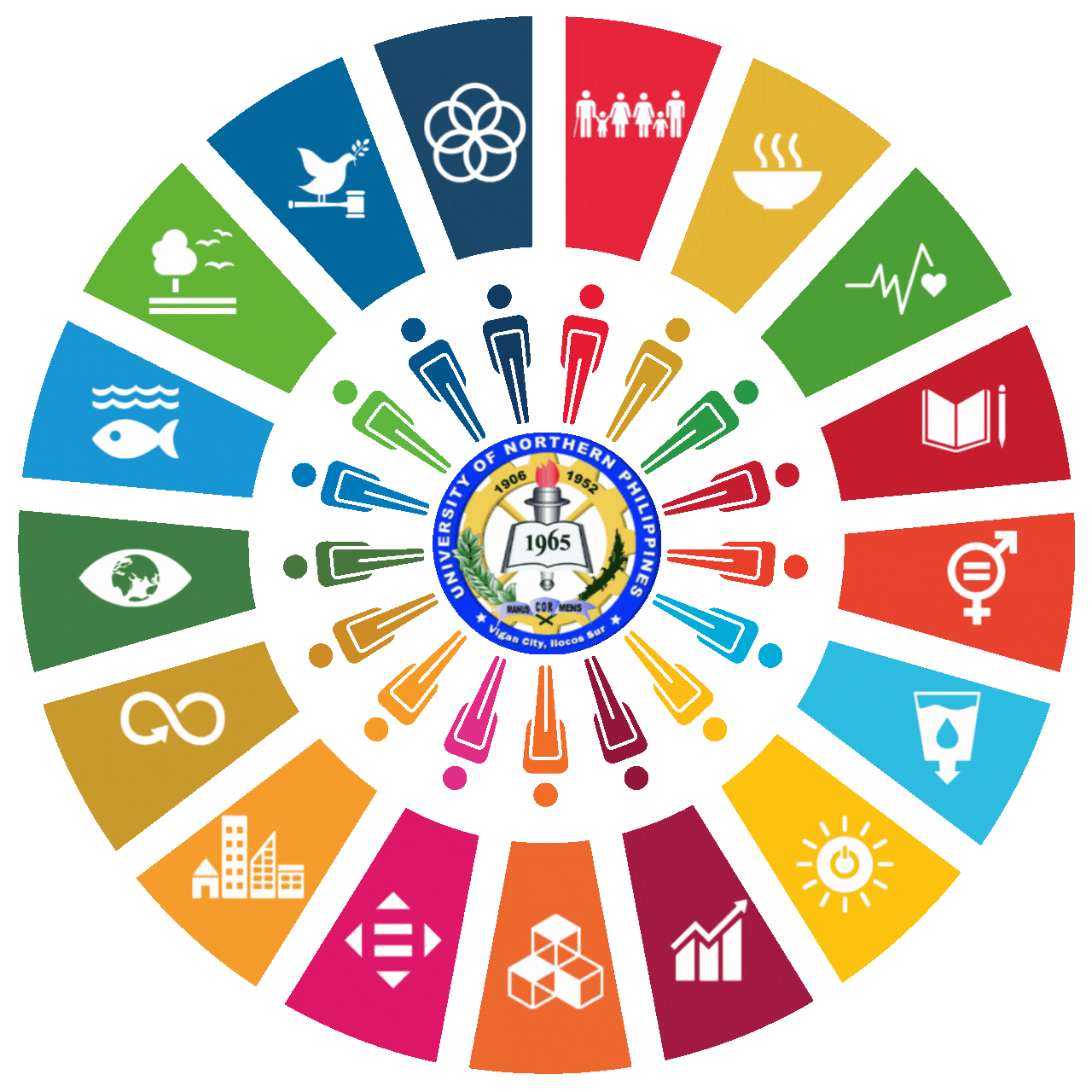

SDG 16 - PEACE, JUSTICE AND STRONG INSTITUTIONS
The University of Northern Philippines (UNP) demonstrates a strong commitment to Sustainable Development Goal 16: Peace, Justice and Strong Institutions through its comprehensive approach to promoting peaceful, and inclusive societies, providing access to justice, and building effective, accountable institutions.
Predicting Countries with Low and High Robbery Rates Using Discriminant Analysis
Proponent: Joseph G. Taban, Dolores R. Bersamina, Randolf M. Agup
Abstract
Crime such as robbery has been identified as one of the socioeconomic problems across the world, which adverse social, economic, and family conditions have caused. Using discriminant analysis, this study proposed a model for classifying and predicting countries with low and high robbery rates. Robbery rates in 2018 of 42 countries across the world have been extracted from United Nations Office on Drugs and Crime as the dependent variable. Meanwhile, the independent variables included the unemployment rate, average household size, and poverty index. The study originally classified 32 countries with low and 10 with high robbery rates. Pretesting was employed, and the results showed that all the assumptions for discriminant analysis were fulfilled. Using standardized beta and Wilk’s Lambda, the average household size is the best predictor variable, while the unemployment rate is the least predictor variable. The overall prediction function model is significant. The classification results by discriminant analysis algorithm for groups with low and high robbery rates show that the proposed model correctly predicts 78.6% of the robbery rates of countries based on the three characteristics, such as their unemployment rate, average household size, and poverty index.
Keywords: Robbery rates, discriminant analysis, unemployment rate, average household size, poverty index
Domestic Violence Against Women: A Global Perspective
Proponent: Remedios T. Navarro, Cid A. Javier, Edelyn A. Cadorna, Grace A. Garcia, Bonna Mae S. Gorospe
Abstract
Women’s physical, reproductive, and emotional health are all significantly impacted by intimate partner violence (IPV), which is now recognized as a serious public health issue. According to the feminist paradigm, intimate partner violence is a complex issue that involves both socio-cultural and psychological elements interacting. To realize an accurate cluster of countries and develop a statistical model to explain the prevalence of domestic violence against women, a data mining model of global domestic violence against women’s incidence was constructed. The research results show three clusters among the countries from the different regions of the world, characterized by the variables considered. Moreover, the results reveal that the poverty gap, literacy rate, alcohol consumption of men, the share of the population with alcohol or drug use disorders, prevalence of anxiety disorders in women, and prevalence of depressive disorders in both men and women came out as significant predictors.
Keywords: global domestic violence, feminist theory of violence, cluster analysis, discriminant analysis
Ethical Literacy Criticism and Ariel Sotelo Tabag's Panangsapul iti Puraw a Kabalio
Proponent: Mark Louie Tabunan
Abstract
Nie Zhenzhao’s ethical literary criticism provides a new take on ethics in literature, emphasizing the historicity of ethics and providing a new toolkit in understanding ethical dilemmas in literary texts. This article deploys ethical literary criticism in reading Panangsapul iti Puraw a Kabalio [Search for the White Horse], a marvelous realist novel by award-winning Ilokano writer Ariel Sotelo Tabag. Focusing on the ethical knots encountered by the four characters of the Tabaco clan, it examines the ethical choices they made against the backdrop of the ethical environments of the Second World War and the Martial Law period. Examining the life narratives of the characters reveals the ways in which their ethical choices are for vanquishing the horrors of the past so that they may live a better future. Building on Danilo Alterado and Aldrin Jaramilla’s maiyannatup a panagripirip, the article also reflects on the transplantation of ethical literary criticism in the Ilokano context to extrapolate a vernacular form of ethical consciousness which marks cultural difference and is astute to the cultural and historical concatenations and literary tradition in which the text and the author are imbricated.
Keywords: Ariel Sotelo Tabag, ethical choice, Panangsapul iti Puraw a Kabalio, ethical literary criticism, Ilokano literature
Arem wennu Raem (admiration or respect): A phenomenological understanding of Ilocano courtship
Proponent: Chase Mark S. Suyat, Mae Angelie V. Salvador-Garcia, Julie May N. Molina
Abstract
The study was conducted to determine the real meaning of “panagarem” in the concept of Ilocano and its evolution, ways, and practices through the years. This study employed phenomenology using individual interviews. There were 4 participants from each generation. The study revealed that panagarem” plays an essential role in understanding the deeper meaning of Ilocano courtship with new strategies in the courting of the Ilocanos, whether traditional or modern style. The custom of Ilocano panagarem requiring a certain man to work for the woman’s family was a “long, arduous, and expensive process of courting. A series of friendly dates is the normal starting point in the Ilocano way of courting, and it is usually beginning with “sinuron” or the process of teasing, a process of pairing off a potential couple. Moreover, material things are the basis of settling down, because they are focused on the idea of stability. However, some of the previous practices are not going away; they use them until now. However, some practices have been added because of technology and social media platforms. However, the bottom line here is that the respect and honor of the parents of the “Maarar-arem” are still practiced in different generations. That concludes that “Panagarem” is also “Panag- Raem.
Keywords: courtship, “Panagarem” evolution, modern courtship, traditional courtship
When Freedom is Regained: The Life Experiences of Persons Deprived of Liberty after Incarceration
Proponents: Dolores R. Bersamina, Aurora R. Quero
Abstract
The study focuses on the experiences of Persons Deprived of Liberty (PDLs) after regaining their freedom. The transition to life outside prison can be challenging, potentially leading to reintegration or disintegration. Researchers used transcendental phenomenology to extract vital information from 10 PDLs, identifying significant themes to better understand their situations. The idea of living outside the jail can bring mixed feelings, with excitement and hope but also uncertainty and worry. PDLs struggled to fulfill their obligations to their families and faced social disapproval and the temptation to end their lives as a form of escape. Despite these challenges, their connection and faith in God prevailed, and they realized the importance of becoming a better person for reintegration. The PDLs’ vision is to provide for their families and sacrifice their own happiness for a selfless life disposition. The vision of young PDLs living a happy life with loved ones, spouses, or marriage is equally important.
Keywords: Freedom, Regained, Persons Deprived of Liberty, Transcendental Phenomenology, Reintegration
Cultural Tangible Properties: The Development of the Candon Heritage Resources conservation Plan
Proponents: Ludivina Abaya Lozano
Abstract
The City of Candon in Ilocos Sur, Philippines, is rich in culturally built heritage, particularly houses of ancestry. The City identifies ancestral houses, while other buildings and structures are not included in the list but can already be considered part of the culturally built heritage. Collectively, these cultural resources are within a proposed heritage district of the City, including a heritage growth corridor–where the high concentration of such resources is located — that may serve as a visual representation and act as a living museum of the area. This study formulated a proposed Heritage Resources Conservation Plan to preserve and protect the identified built heritage resources in Candon City. A field survey was conducted to identify and map the local heritage resources and their cultural significance. Upon identification of the City’s heritage district, several guidelines regarding further development in the area, especially along the heritage corridor, were recommended to preserve and protect these cultural resources from possible deterioration and destruction.
Keywords: Cultural Tourism, Heritage Zone, Built Heritage, Local heritage Resources
The Untold Stories of People Who Had Suicidal Ideations: A Phenomenological Study
Proponents: Krista B. Manzano, Pe R. Asuncion, Blessie Ann R. Cabato, Andrea Mae F. Jimenez, Alyssa Jane B. Palacpac, Cherry B. Banilad
Abstract
This study explored and described the lived experiences of people who had suicidal ideations. It gathered information and real-life experiences to reveal the significant life stories of persons with suicidal thoughts. Descriptive phenomenology was employed to explore and describe the lived experiences of young adults who had suicidal ideation. The study included eight participants who were selected purposively. A semi-structured individual interview was utilized in gathering the data. Data analysis was done immediately after every data collection using Colaizzi’s seven-step processes. This study has three central themes that emerged from the data which included a) emotional experience, b) life’s crisis, and c) sparks of hope in life. The main themes are classified into eleven categories: the feeling of emptiness, feeling of worthlessness, feeling of emotional pain, feeling of giving up, family conflict, intrapersonal conflict, challenging life situations, isolation, restoration and installation of hope, sustaining positive relationships, and sense of life. This research revealed that all have their battles to fight. Coping with their issues, becoming independent, and trying to bridge the gap between their dear ones and, most importantly, with themselves entail emotional labor, as each participant from a different context with different backstories shared their unique experiences. Therefore, student nurses should uplift these vulnerable groups’ spiritual values and morals and encourage them to vent their feelings to trusted friends.
Keywords: Suicide, ideations, real-life, experiences, young adult
Development of Gaynek Ta Cabiga-O: A Way to Strengthen the Panaglaga Culture
Proponents: Adrian Keith M. Serna, James Carlo Asuncion, Revenson S. Saniatan, Erwin H. Sumagit Charlie V. Tapuro, Matilde T. Concordia
Abstract
“Gaynek ta Cabiga-o” emerges as a creative dance form inspired by the traditional artistry of crafting winnowing baskets, known as “panaglaga ti bigao,” deeply embedded in the cultural fabric of the Itneg tribe in Nagsincaoan, Cabugao, Ilocos Sur. This exploratory-sequential approach research blends qualitative insights from interviews and participatory observations with quantitative analysis through validated questionnaires from five participants. Guided by the Communities of Practice (CoP), the study’s focal point is to enhance and preserve the Panaglaga Culture by delving into the intricate stages of crafting bigao. This endeavor culminates in the creation of a dance, intricately weaving together traditional movements, such as bamboo cutting (panagpukan) and weaving (panaglaga), into a cultural expression. Key materials integral to panaglaga ti bigao include bamboo, customized knives, lebleb, uway, labtang, kulokol, bamboo strips, and residue. The resulting dance undergoes expert evaluation, receiving a “Very Much Acceptable” rating for dance steps and music. In essence, “Gaynek ta Cabiga-o” not only breathes new life into cultural practices but also serves as a testament to the community’s commitment to cultural preservation and creative innovation. Recommendations based on these findings pave the way for further cultural enrichment and community engagement.
Keywords: Culture, indigenous people, panaglaga, creative dance
Roses After the Thorns: Challenges and Coping Among the Spouses of Uniformed Personnel
Proponents: Alma Josefina A. Bobita, Wendelyn R. Talbo
Abstract
This study explored and described the experiences of the spouses of uniformed personnel, specifically on their challenges and coping. It employed the transcendental phenomenology design to understand the experiences of the spouses of uniformed personnel. Semi- structured interviews were utilized to elicit information to answer the research questions. The interview was conducted using telephones, cellphones, and video calls. The participants were spouses of uniformed personnel who rendered ten years and above in service. The study revealed that uniformed personnel spouses were confronted with challenges because they have their unique ways of coping with various challenges. These challenges are time, stress, and nervous breakdown. Their coping mechanisms are faith in God and understanding the nature of work. The Armed Forces of the Philippines must organize activities involving all the family members of the spouses of the uniformed personnel.
Keywords: challenges, spouses, experiences, uniformed personnel, coping
Ilokano-Ness Of Bain Ken Basol: A Phenomenological Inquiry
Proponents: Aldrin S. Jaramilla, Lloyd A. Mata, Simeon Abarquez IV
Abstract
This study aims to metaphysically explore, interpret, and establish how the Ilocanos in the northern part of the Philippine islands experience bain ken basol, understood as shame and sin or guilt, during moral failure and how they resolve it. The research method used is a qualitative research design employing the philosophic phenomenological method that comprises the four intertwining steps of 1) epoche, 2) phenomenological reduction, 3) imaginative variation, and 4) synthesis. Vital information had been explored from thirty informants represented by the young, middle-aged, and old generations through in-depth, semi-structured interviews or open-ended questioning. The findings of the study revealed that thecultural complexities and the perspectival and contextual concepts of the Ilocano society have established a progressively multifaceted psychoanalytic intersubjective ground. The discussions of the experiences and concepts built up on bain ken basol further boiled down to four theories, namely: theory of distinctiveness, theory of oneness, theory of accommodation, theory of interconnectedness, theory of relational responsibility.
Keywords: shame, sin-guilt, intersubjective, grounded theories
Preliminary Notes from Oral History and Literature on the Baldi of Ilocos Sur, Philippines
Proponents: M.L. I. Ingel, Fatima Nicetas A. Rabang-Alonzo, Uldarico A. Pacada, G.A. Retuta and Renato B.Navarro
Abstract
Stone or brick-and-lime vats locally referred to as baldi occur across the province of Ilocos Sur, Philippines. Many of the baldi must have been constructed for the purpose of natural indigo dye production from the locally-grown indigo plant. This was important to the Ilocos economy and contributed to the wealth of the historic town of Vigan listed as a UNESCO World Heritage Site. However, some vats had been used for different production activities, including those that apparently changed function at certain points in time, attributable to the shifts in the economy of the region. Most or all of the vats had ceased being utilized for livelihood-related production since around the 1960s or even earlier. Overall, the vats should be viewed not as generic cultural features with a single function, but as tangible cultural heritage that must have had a variety of functions across space and time given site-specific and dynamic environmental, economic, and cultural contexts. They merit further historical-archaeological research, particularly in relation to the history of Vigan.
Keywords: baldi, indigo vats, indigo dye, built heritage, heritage protection
Assessment of the Spiritual Nursing Care Competencies of Nursing Students in the Ilocos Region, Philippines: A Descriptive Correlational Study
Proponents: Epifania Marlene R. Purisima, PhD, RN and Norenia T. Dao-ayen, PhD, RN
Abstract
The study aimed to assess the spiritual nursing care competencies of BSN students in Region 1 through the utilization of a descriptive-correlational research design involving the 424 Levels 2 – 4 BSN students and 125 clinical instructors from 14 selected higher education institutions. Data were gathered through questionnaires and were analyzed using frequency percentage, mean, and Pearson Correlation Coefficient. Findings revealed that the extent of the spiritual nursing care competencies of BSN students in Region 1 is moderate (spiritual nursing knowledge: x ̄= 11.18; spiritual values: x ̄= 3.77; and spiritual nursing skills: x ̄= 2.76). There is a very weak positive, statistically significant correlation between the students’ year level and spiritual values (r = 0.135, SD = 0.63, p < 0.01) and spiritual nursing skills (r = 0.153, SD = 0.62, p < 0.01). Furthermore, a very weak inverse significant relationship was revealed between the school category (r = -0.113, SD = 0.62, p < 0.05) and the level of accreditation (r = -0.101, SD = 0.62, p < 0.05) to their spiritual nursing skills. The BSN students in Region 1 are reasonably competent in rendering spiritual nursing care. Their year level, school category, and school accreditation are important factors to better spiritual nursing skills. As they advance in the year level, they are likely to assimilate spiritual values that are indispensable in delivering spiritual nursing care. However, amidst this favorable competence, clinical instructors still see the students as work in progress, capable of excelling. Thus, the utilization of the training module, which is an output of this endeavor, can help the nurse educators mold BSN students to advance their spiritual nursing care competence.
Keywords: baldi, indigo vats, indigo dye, built heritage, heritage protection
Young Adults' Intrapersonal Construct of Sexual Harassment
Proponent: Irene Abigail S. Guerrero, DComm
Abstract
There is little literature discussing the construction of meaning at an individual level about sexual harassment. This study presented the level of perception of males and females on sexually harassing content and discussed how males and females construe sexual harassment. Using integrated mixed methods and employing quota sampling, 400 respondents from the Ilocos Norte and Ilocos Sur provinces participated in the survey, and 10 participants were interviewed. Based on the study results, females and males have varying levels of perception of verbal, visual, physical, and digital body language constructs relating to sexually harassing content. Their levels of perception of sexually harassing content are more pronounced in same-sex communication; female-to-female, and male-to-male communication events. Further, the construct of sexual harassment was influenced by the sender’s and recipient’s gender and sex, degree of intimacy in relationships, and non-verbal communication. Future studies could explore policy sciences, computer-mediated communication, and misinterpretation and miscommunication in within sexual harassment issues.
Keywords: baldi, indigo vats, indigo dye, built heritage, heritage protection


















